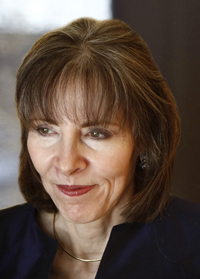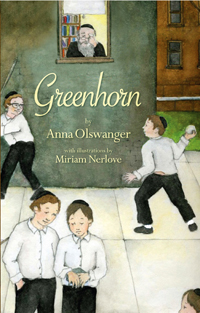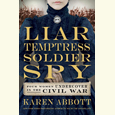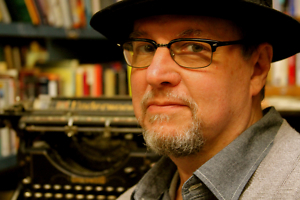The Box of Hope
Memphis native Anna Olswanger has written a tiny but powerful book of Holocaust literature for middle-grade readers
A tiny novel with an enormous heart, Anna Olswanger’s Greenhorn poignantly illustrates the old adage that good and powerful things often come in the smallest packages. This book for children tells the story of Daniel, a young Polish Holocaust survivor who arrives at a Brooklyn yeshiva in 1946, carrying nothing but a small tin box.
Silent and withdrawn, Daniel never lets the box out of his sight, refusing to reveal its mysterious contents despite the other boys’ constant bullying and taunts. His sole ally is his classmate Aaron, a kind, stoic boy whose stutter makes him a fellow object of the boys’ derision. In time, Aaron discovers that Daniel’s box holds one remaining physical tie to his parents, who died in a concentration camp. A simple but deeply affecting story of friendship, resilience, and hope, Greenhorn is as heartbreaking as it as brief, and a powerful addition to the canon of Holocaust literature for children.
 Olswanger is a Memphis native, literary agent, and author of two other children’s books, including the award-winning Shlemiel Crooks. She first heard the story that inspired Greenhorn from her rabbi, on whom the character of Aaron is based. The tale haunted her, and she felt compelled to write it down but was uneasy about laying claim to what she’d heard. “How could a childless woman, born in America after the Holocaust, whose ancestors had left Eastern Europe in the 1890s, tell this story of a little boy who couldn’t let a tin box out of his sight?” she wrote in a Publishers Weekly column about the genesis of Greenhorn.
Olswanger is a Memphis native, literary agent, and author of two other children’s books, including the award-winning Shlemiel Crooks. She first heard the story that inspired Greenhorn from her rabbi, on whom the character of Aaron is based. The tale haunted her, and she felt compelled to write it down but was uneasy about laying claim to what she’d heard. “How could a childless woman, born in America after the Holocaust, whose ancestors had left Eastern Europe in the 1890s, tell this story of a little boy who couldn’t let a tin box out of his sight?” she wrote in a Publishers Weekly column about the genesis of Greenhorn.
In fact, telling the rabbi’s story turned out to be a cathartic journey for Olswanger. “I went from being a woman saddened by not having her own family to being a woman immersed in the joy of children’s books as an author and literary agent—and in my middle 50s, a woman who married for the first time,” the essay continued. “I have a husband now, the start of my own family. So part of the story is mine now, too. The part that is hope. It may be tough to sell a children’s book about the Holocaust, but it’s even tougher not to have hope.”
Ideal for families with middle-grade children to read together, Greenhorn “can jump-start a discussion of the Holocaust, as well as the repercussions for those who survived and, indeed, for all humanity,” wrote a reviewer for Kirkus. To that end, the book’s publisher, NewSouth Books, offers free discussion and teaching guides for families and teachers on its website. Olswanger answered questions about the book from Chapter 16 via email:
Chapter 16: Greenhorn is inspired by a true story. What aspects of the story particularly compelled you to write a fictional version of it?
Olswanger: When I first heard the story about a little boy who had lost his family in the Holocaust and who wouldn’t let a tin box out of his sight, one of the things I couldn’t stop thinking about was his loneliness. He had lost his parents, siblings, and extended family to the Nazis. He had no one left who shared his memories, no brother or sister, no parent, no aunt or uncle. And what he latched on to, literally, was a tin box that held something he considered a connection to his family. It was his loneliness I wanted to write about.
 But as I began to write Greenhorn, through all the succeeding drafts of what became a middle-grade novel based on a real story, what struck me was that the little boy made a friend, and that later he agreed to live with his friend’s family, and that at the very end, in the scene I described in the afterword, the little boy grew up to marry and have his own family, and was finally able to bury the contents of the tin box in his backyard in Jerusalem. I discovered through all those successive drafts that I was writing about family.
But as I began to write Greenhorn, through all the succeeding drafts of what became a middle-grade novel based on a real story, what struck me was that the little boy made a friend, and that later he agreed to live with his friend’s family, and that at the very end, in the scene I described in the afterword, the little boy grew up to marry and have his own family, and was finally able to bury the contents of the tin box in his backyard in Jerusalem. I discovered through all those successive drafts that I was writing about family.
Chapter 16: This novel is very brief, but its themes are potent. Was the scope of the story something you debated with yourself, or were you certain of its parameters from the start?
Olswanger: Suzanne La Rosa at NewSouth Books debated whether the story was long enough to be a book, and that perhaps we should put two stories together. But finally we all decided that the themes of Greenhorn dictated that it be its own book, however short.
Greenhorn is also short because I wanted to write only the story I heard. I didn’t want to add backstory or previous history for the character I named Daniel. Rabbi Rafael Grossman, who was the basis of the “Aaron” character and who told me the real story in the 1980s when I was still living in Memphis, didn’t remember every detail forty years later. And he certainly didn’t remember every detail seventy years later when the story was about to be published and I was revising it one last time. So I had to fictionalize parts of what he told me. Because I was concerned about the ethics of creating fiction based on the Holocaust, and because I wanted to honor what the real Daniel went through, I focused entirely on the events I heard, and refrained from inventing anything from the time of the Holocaust itself when Daniel may have been in a concentration camp. The result was a short novel.
Chapter 16: In 2006 you published a limited-edition version of Greenhorn—an even smaller version; a true miniature book. Can you tell us a bit about it?
Olswanger: I self-published Greenhorn as a miniature book for Judaica collectors. I had discovered miniature books a few years earlier, books that have to be smaller than three inches in height and width, and I fell in love with the format. Nothing is wasted in a miniature book, which holds a complete and focused story, often in a beautiful hand-made binding. For several years I was a member of the Miniature Book Society and enjoyed collecting miniature books myself.
A few months after I sent the miniature version of Greenhorn to Suzanne LaRosa, the publisher of my first children’s book, Shlemiel Crooks, as a holiday gift, she called to say she wanted to publish Greenhorn. She said it was a provocative little book (this is the publisher who took the “N” word out of Huckleberry Finn, so she’s no stranger to being provocative) and that the book’s image of a tin box and its contents haunted her.
Chapter 16: What drew you to the making of miniature books?
Olswanger: As a child, I loved The Borrowers, which either exemplifies my fascination for small things, or is the origin of my fascination.
Chapter 16: In what ways do you hope Greenhorn will add to the canon of Holocaust literature for young people?
Olswanger: There are many reasons to write about the Holocaust. Most people agree with philosopher George Santayana (and before him, Edmund Burke) that those who cannot remember the past are condemned to repeat it. So one reason people continue to write about the horrors of the Holocaust is to ensure that the horrors will never happen again. I don’t totally agree with that reasoning. I think it’s important to write about the opposite of the horrors—the acts of courage and kindness, even if small—because acts of courage and kindness are what we want to repeat, not acts of cruelty. So, what I hope Greenhorn will add to the canon of Holocaust literature for young people is a story of a child who suffered horribly, but who left his past behind with the help of a friend. I want young readers to see Greenhorn as a story of hope.
Chapter 16: So many people say they long to write books for children. Any advice for them, as an author or as a literary agent?
Olswanger: The quick answer is “Start writing.” Published writers don’t sit around and talk about writing, they write. And yet, I’m not sure people can push themselves to write. If they’re not writing, then they’re getting something out of not writing. Maybe they are afraid of not doing justice to their story. And maybe the time just isn’t right yet, which means they need to read more, or experience more. But I will say, even if they’re not ready to write their book, they can start keeping a journal. The act of writing is a way of thinking, and maybe that act of thinking on paper for a few minutes each day will ease these people into writing their book for children.





